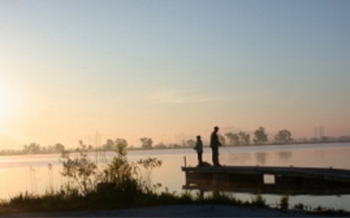Over the Line
Click here to read a book review.

Click here to read a book review.
Over the Line records the trials and triumphs of the Association for the Wolf Lake Initiative (AWLI), a single, not-for-profit bi-state organization seeking to improve and enhance a watershed in Southeast Chicago and Northwest Indiana. The area is known as the Calumet region, which evolved over the years from a swampy hunting and trapping ground into a steelmaking haven that first rivaled and then surpassed that of the Pittsburgh area.
The first impression of Wolf Lake by many is that of an industrial backwater as they peer down on it while driving on Chicago’s Skyway and the Indiana Toll Road (I-90) from Chicago to the Indiana Dunes National Park and other destinations to the east. The span over Wolf Lake runs the length of the lake from north to south, separating Chicago from Hammond, Cook County from Lake County, and Illinois from Indiana. Wolf Lake’s north channel that runs past Cargill Inc.--for years known as Amaizo Products--hides toxic wastes buried in silt and kept undisturbed for decades. Organized local protests fought off attempts to convert nearby George Lake into a landfill and, more recently, parts of Wolf Lake and neighboring communities into an airport. Unilever still dumps water into Wolf Lake that is taken from Lake Michigan and used to cool plant machinery.
Yet the Wolf Lake watershed has survived these affronts, scarred but also amazing at what it still offers visitors. Its waters are cleaner than those of the Lake Michigan basin. Years of dredging have made Wolf and nearby Powderhorn Lakes prime fishing grounds. Today, winds that sweep Wolf Lake’s Indiana shoreline during spring and autumn attract windsurfers from as far away as Wisconsin and Michigan. They compete for space with sailing vessels from the Illiana Yacht Club and small fishing boats. From duck blinds off Chicago’s shoreline, hunters shoot waterfowl from October to January. Watershed shorelines consist mostly of slag and other fill debris, remnants of less enlightened times. But some of the adjoining areas enjoy a highly diverse plant growth inhabited by wildlife both common and rare.
Over the Line traces the organization’s birth from 1999 through early 2019. From these pages, readers will learn of achievements made by hundreds of individuals brought together to preserve and enhance the Wolf Lake watershed. They’ll travel the self-guided tour of the Wolf Lake watershed. They’ll learn what Wolf Lake means to others through their recorded memories. They’ll review the history and achievements of AWLI and learn what AWLI has yet to do and has yet to offer in the upcoming decades.
Readers should benefit in other ways. They’ll bear witness to the trials and triumphs experienced in establishing a not-for-profit and then sustaining it for two decades. They’ll be introduced to the fragile world of governing by consensus and the trials and triumphs that accompanied that effort.
The book would be useful to educators who want to present a case study of environmental non- profits at the undergraduate and graduate levels. The book would also be useful to those practitioners who want to understand the significant challenges of developing environmental policy in a region characterized by political and economic divisions that are typical of former manufacturing areas. The potential audience would include those raised in the Calumet region and those environmentalists in the Chicago metro region and Northwest Indiana. Also benefitting from the book would be those contemplating the creation of a not-for-profit anywhere in the nation. This would apply even more so to those in the ecology and environmentalmovement. The recording of AWLI’s experiences would help anyone entering the non-profit field and dealing with local, state and federal agencies.
Over the Line is primarily a history of volunteers working to protect and enhance a watershed. Those who study ecology and urban politics might also benefit from reading the book. And finally, those who champion the underdog also might find the book rewarding.
Over the Line comprises more than 300 pages. Chapters are organized in three sections.
Section I comprises chapters one through four, which focus on the resource, the watershed. Memories by neighbors of the watershed fill one chapter.
Section II comprises three chapters which describe efforts to pursue the mission of protecting and enhancing the watershed.
Section III comprises three chapters which record efforts to sustain the organization. A fourth summarizes efforts to do so, with assessments of AWLI’s success made by others. A fifth was added to summarize events of the final decade An epilogue and 15 appendices follow.
Dr. Jim Lane, retired professor of history at Indiana University Northwest, and reviewing author Cynthia Ogorek find the book to be unique in scope, subject matter and presentation.